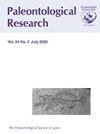Theme Issue “Renaissance for Paleozoic Eolution Studies: Radiation and Extinction”: Preface for Part 2
IF 0.6
4区 地球科学
Q3 PALEONTOLOGY
引用次数: 0
Abstract
This is the Part 2 of the thematic issue; Part 1 was published in Paleontological Research (PR) vol. 25 in 2021. Part 2 adds two more articles that introduce new views and concepts for Paleozoic paleontology, i.e., one for Early-Middle Paleozoic microfossil studies from the long-term terra incognito, central Asia, and the other for essential reconsideration of the causes for the Phanerozoic major extinctions from a non-conventional cosmoclimatology viewpoint. Obut (2023) introduces the latest knowledge on Early Paleozoic micropaleontology from Siberia where precious pieces of information are potentially archived for the lost ocean called the Paleo-Asian Ocean. In addition to classic fossils, such as graptolites and trilobites, a long list of conodonts and radiolarians recently became available from cherts, mudstones, and some limestones. These new fossil data provide prime clues for reconstructing the biogeographic provinciality and geotectonic setting of the Paleo-Asian Ocean. It is noteworthy that the essential research scheme for those ancient mid-oceanic sediments was imported from Japan (e.g. Buslov and Watanabe, 1996; Iwata et al., 1997; Uchio et al., 2004; Ota et al., 2007), and thus is highly suitable for publication in PR. Isozaki (2023) reviews studies on the causes of the Phanerozoic mass extinctions, emphasizing the categorization of previously proposed causes into four distinct groups (see Isozaki, 2019). Besides the currently widely discussed possible causes, such as bolide impact and a large igneous province, a new possibility—non-bolide extraterrestrial effects—is explored on the basis of the astrophysical observations of galaxies (e.g. Rocha-Pinto et al., 2000; Ruiz-Lara et al., 2020) and a new line of material evidence from deep-sea cherts in Japan. The latest finding of an unusually high helium isotope ratio (3He/4He) from the Permo-Triassic boundary extinction interval (Onoue et al., 2019; Takahata et al., 2019) suggests that our Solar System had encountered a dark cloud and that abundant interplanetary dust particles have Theme Issue “Renaissance for Paleozoic evolution studies: radiation and extinction”: Preface for Part 2主题议题“古生代演化研究的复兴:辐射与灭绝”:第二部分前言
这是主题问题的第二部分;第一部分于2021年发表在《古生物研究》(PR)第25卷。第二部分增加了两篇文章,介绍了古生代古生物学的新观点和新概念,即一篇是关于中亚长期未被发现的早-中古生代微化石研究,另一篇是从非传统的宇宙气候学角度对显生代大灭绝的原因进行了必要的重新思考。Obut(2023)介绍了西伯利亚早古生代微古生物学的最新知识,在那里,宝贵的信息有可能被存档,用于被称为古亚洲海洋的失落海洋。除了笔石和三叶虫等经典化石外,最近从燧石、泥岩和一些石灰石中发现了一长串牙形刺和放射虫化石。这些新的化石资料为重建古亚洲海洋的生物地理区域和大地构造背景提供了重要线索。值得注意的是,这些古中大洋沉积物的基本研究方案是从日本引进的(例如Buslov和Watanabe, 1996;Iwata等人,1997;Uchio et al., 2004;Ota et al., 2007),因此非常适合在PR上发表。Isozaki(2023)回顾了显生宙大灭绝原因的研究,强调将先前提出的原因分为四个不同的组(见Isozaki, 2019)。除了目前广泛讨论的可能原因,如火成岩撞击和大火成岩省,在星系天体物理观测的基础上,探索了一种新的可能性-非火成岩地外效应(如Rocha-Pinto et al., 2000;Ruiz-Lara et al., 2020)以及来自日本深海燧石的新材料证据。在二叠纪-三叠纪边界灭绝区间发现异常高氦同位素比率(3He/4He)的最新发现(Onoue et al., 2019;Takahata et al., 2019)表明我们的太阳系遇到了一团黑云,并且大量的行星际尘埃粒子。主题议题“古生代进化研究的复兴:辐射和灭绝”:第2部分的序言
本文章由计算机程序翻译,如有差异,请以英文原文为准。
求助全文
约1分钟内获得全文
求助全文
来源期刊

Paleontological Research
PALEONTOLOGY-
CiteScore
1.60
自引率
0.00%
发文量
47
审稿时长
>12 weeks
期刊介绍:
Paleonotological Research (PR) is a quarterly, peer-reviewed international journal, which focuses on original contributions primarily in the area of paleontology but also covering a wide range of allied sciences. It has been published since 1997 as a successor to the former journal Transactions and Proceedings of the Palaeontological Society of Japan. The emphasis of contributions will include global and local perspectives, and contents can cover all ages (Precambrian to the Quaternary, including the present time).
 求助内容:
求助内容: 应助结果提醒方式:
应助结果提醒方式:


